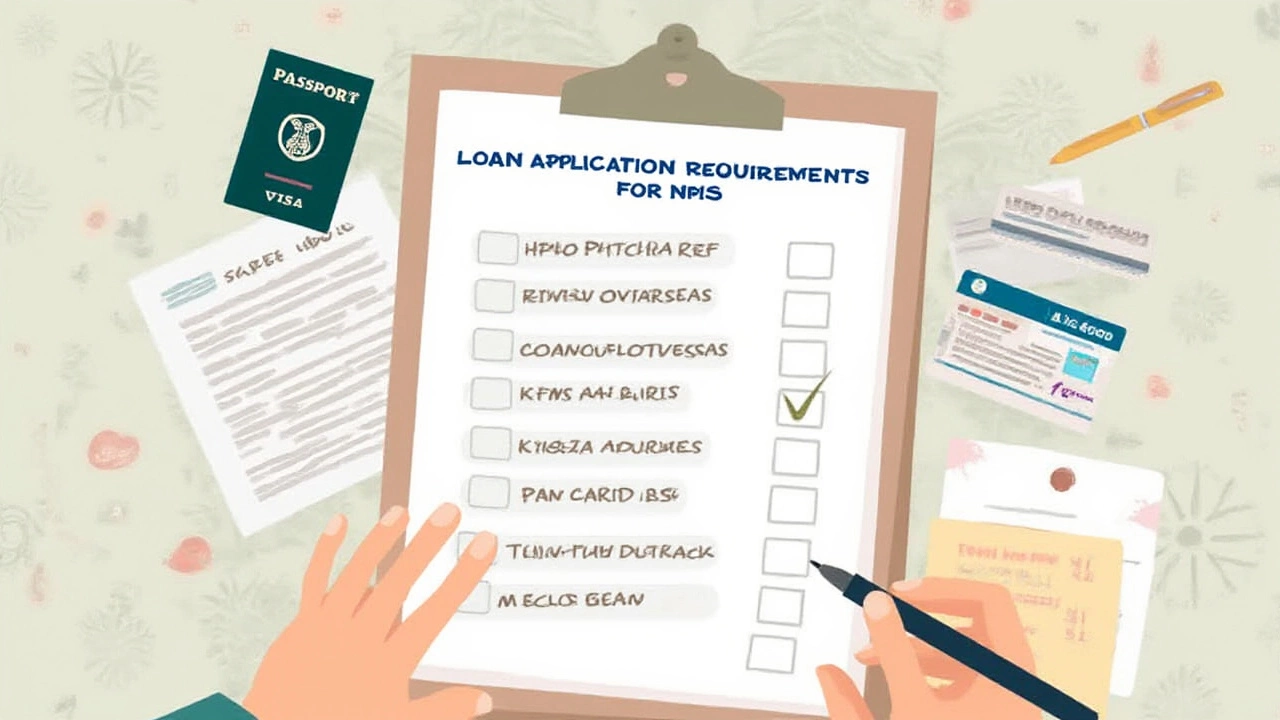Ever tried to convince your bank back home that you still exist—and want a loan—while sipping your coffee thousands of miles away in another country? The struggle is real. NRIs (Non-Resident Indians) wrestle with a weird mix: sentimental ties to India and the cold digital walls of lending policies. Between WhatsApp calls, missed OTPs, and documents lost in international couriers, it feels like getting a loan from an Indian lender is a quest for the patient and persistent.
If you’ve ever asked, “Can I get a loan in India if I live abroad?” you’re definitely not alone. Every day, Indian banks and NBFCs get thousands of requests from NRIs in the US, UK, UAE, Australia, and beyond, wanting to snag a loan for everything from a dream Mumbai flat to a quick emergency cash crunch. Despite assumptions, Indian lenders are opening up more than ever. But red tape? Still plenty of that—unless you know the tricks.
What Types of Loans Can NRIs Get in India?
Not every loan you hear about in India can be handed out to NRIs. There are restrictions—mostly around consumer credit, high-risk advances, and business loans. But there are solid options if you know where to look.
Indian lenders usually welcome NRIs for the following loans:
- Home Loans: The most popular choice. Banks like SBI, HDFC, ICICI, and Axis have special NRI loan branches.
- Personal Loans: Trickier for NRIs, but some banks and NBFCs offer them for emergencies.
- Car Loans: Available if you want to buy a vehicle in India for family or for when you visit home.
- Education Loans: For your or your dependents’ studies in India or even abroad.
Banks focus on loans backed by collateral. For example, home loans are backed by property, so lenders feel safe when offering NRI financing. On the flip side, unsecured personal loans are rare unless you have a stellar credit record in both India and your country of residence (and some serious luck.)
Check out this table showing NRI loan types and their basic eligibility factors:
| Loan Type | Eligibility Highlights | Loan Tenure | Interest Rate (as of July 2025) | Max Amount |
|---|---|---|---|---|
| Home Loan | NRI status, Indian income/property co-applicant required usually | Up to 20 years | 8.75% - 10.25% | Up to ₹7 crore |
| Personal Loan | Salary & Indian co-applicant/guarantor often needed | 1-5 years | 11% - 15% | Up to ₹40 lakh |
| Car Loan | Documented income, Indian contact person | 1-7 years | 8.9% - 13.5% | Up to 90% of car value |
| Education Loan | Indian co-applicant, admission proof | 1-15 years | 8% - 12% | Up to ₹75 lakh |
Fun fact: Over 70 banks and NBFCs in India offer loans to NRIs as of 2025. NRI home loans alone see over ₹12,000 crore disbursed annually.
But what about business loans or startup funding? Getting those from Indian banks is very tough if you aren't physically present or don't have a resident co-applicant. RBI rules tightly regulate lending to non-residents, especially for unsecured credit. Want a business loan? Try specialized NRI loan schemes or partner with someone who lives in India full-time.

Nitty Gritty: Who Qualifies for NRI Loans and What Do Lenders Really Want?
So what does a bank actually need from you if you’re living abroad? First, you must have legal NRI status—basically, you’re an Indian citizen living outside India, either as an employee, business owner, or even as a seafarer. PIO (Person of Indian Origin) and OCI (Overseas Citizen of India) card holders usually get similar treatment.
Banks won’t just take your word for it. They’re obsessed with paperwork. Here’s what they typically want:
- Passport copies (with valid visa/residence permit)
- Overseas address proof (utility bills, rental agreement, driver’s license)
- Indian address proof (for your co-applicant or family contact in India)
- Work permit/Job contract or Appointment letter (to prove your income source)
- Bank statements (both Indian NRE/NRO account and foreign bank, last 6-12 months)
- Salary slips/tax returns (to assess income stability)
- Property documents (for home, car or secured loans)
- Power of Attorney (PoA): Critical if you can't visit India. Allows a trusted Indian resident to handle bank formalities for you.
- Eligible co-applicant/guarantor (usually a close relative based in India)
Here’s a curveball: Even if you upload perfect digital scans, banks sometimes demand original notarized copies, attested by an Indian embassy or consulate. COVID-era digital relaxations are fading, so always check the latest rules at your bank.
NRIs often get tripped up by two things: the co-applicant rule and PoA drama. Banks want a local face—someone who can take care of the loan if you vanish or can’t be reached. That’s why nearly 95% of successful NRI loan applications involve a parent, spouse, or sibling still living in India. Foreign addresses and foreign salaries alone rarely cut it.
Now, if you’re working in a country with a stable economy (think US, UK, Singapore, Australia, UAE), lenders treat you as a preferred NRI. You get better rates and fewer questions. Working somewhere riskier? Brace for higher scrutiny or outright rejection.
Banks love stable, white-collar jobs, long employment contracts, and trackable income. Sailors and consultants with constantly shifting contracts might face extra paperwork. If you run a business abroad, banks often treat you as high risk—unless you can prove steady profits for years, and well-documented Indian assets.
NRI loans India are booming, but approval rates hover at around 62%—a lot of rejections are due to incomplete documents, no Indian co-applicant, or confusion over Power of Attorney specifics. Double-check every single requirement, especially the tiny print on the bank’s NRI webpages.

Tactics to Speed Up Your Loan Approval from Abroad (and Mistakes to Avoid)
So you want a fast approval? This isn't a Bollywood movie. You’ll need more than just a charming story. Here’s what truly works, and what to skip.
- Open/Nurture Indian NRE/NRO Accounts. Lenders want tracks in India: salary credits, bill payments, property tax receipts—even if you earn abroad. Keeping money in your NRE/NRO account helps banks see you’re financially active in India.
- Fix Your Credit Score. Indian lenders pull your CIBIL (or Equifax) credit report, even if you haven’t lived in India for years. Pay off old cards, settle any disputes, and get your score above 700—ideally 750+. A small unpaid phone bill from years ago is enough to kill your application.
- Choose the Right Co-applicant. Pick someone trustworthy, responsible, and actually resident in India. Parents and siblings work best. Avoid distant relatives or friends—banks may reject them outright.
- Notarize Early. Mail PoA and key docs via registered courier to India well before deadlines. Indian consulates are slow (sometimes appointments take weeks). Notarize everything ahead of time and keep digital scans ready, just in case.
- Know Your Lender’s NRI Desk. Many major banks have separate NRI teams who understand your situation—use them. ICICI, SBI, HDFC, and Kotak even have WhatsApp support for NRIs. Skip generic helplines.
- Consider NBFCs. Non-Banking Financial Companies may process NRI loans faster than old-school banks, especially for home or car loans. Bajaj Finserv, PNB Housing, and Indiabulls are worth checking.
- Compare Interest Rates and Processing Fees. NRI loan rates can be 0.5%–2% higher than resident rates. Also, watch for added fees—some banks charge “outstation processing” charges for NRI clients.
- Document Everything. Keep email logs, courier receipts, and communication trails from day one. Don’t rely on verbal promises over the phone.
Steer clear of these classic mistakes:
- Last-minute PoA paperwork
- Ignoring CIBIL issues
- Assuming family in India have everything ready (they rarely do)
- Submitting incomplete forms or missing sign-offs (Indian banks love signatures everywhere—don’t skip a single box)
- Choosing unclear property or assets as security (clean legal titles make things way smoother)
Don’t depend on “agents” found online or via WhatsApp. There’s a flood of fake brokers promising “guaranteed NRI loans”—most are scams. Always work with the official bank’s NRI portal or a trusted branch employee.
Want a quick cheat sheet? Here are the big winners for NRI home loans, according to Reserve Bank of India’s 2025 data:
| Bank | Max Tenure (years) | Interest Rate | Processing Time (avg days) | NRI Support |
|---|---|---|---|---|
| SBI | 20 | 8.85%-9.45% | 12 | Dedicated desk, PoA support |
| HDFC Ltd | 20 | 8.90%-10.00% | 10 | Online application, overseas help |
| ICICI Bank | 15 | 9.10%-10.25% | 8 | WhatsApp, global phone lines |
| Axis Bank | 15 | 8.95%-10.50% | 14 | Email, direct NRI team |
No, you don’t need to be physically present in India for most of the process—about 70% of NRI loans are completed end-to-end from abroad by July 2025, as long as your paperwork’s on point. But a trusted co-applicant in India still matters most.
Getting a loan in India from abroad demands patience, persistence, and an obsessive attention to detail. But it’s do-able, even if you’re juggling two time zones, a job, pets (Whiskers, you’re still the best noise-maker during my work calls) and the constant struggle to decode Indian legalese. Stalk your bank’s NRI desk, get your Power of Attorney signed early, rope in your most reliable family member, and keep that CIBIL score squeaky clean. NRI loans India aren’t a pipe dream anymore—they’re just a slightly complicated reality.

